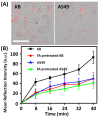Targeting and Photodynamic Killing of Cancer Cell by Nitrogen-Doped Titanium Dioxide Coupled with Folic Acid
- PMID: 28335242
- PMCID: PMC5302625
- DOI: 10.3390/nano6060113
Targeting and Photodynamic Killing of Cancer Cell by Nitrogen-Doped Titanium Dioxide Coupled with Folic Acid
Abstract
Titanium dioxide (TiO₂) has attracted wide attention as a potential photosensitizer (PS) in photodynamic therapy (PDT). However, bare TiO₂ can only be excited by ultraviolet illumination, and it lacks specific targeting ligands, which largely impede its application. In our study, we produced nitrogen-doped TiO₂ and linked it with an effective cancer cell targeting agent, folic acid (FA), to obtain N-TiO₂-FA nanoconjugates. Characterization of N-TiO₂-FA included Zeta potential, absorption spectra and thermogravimetric analysis. The results showed that N-TiO₂-FA was successfully produced and it possessed better dispersibility in aqueous solution than unmodified TiO₂. The N-TiO₂-FA was incubated with human nasopharyngeal carcinoma (KB) and human pulmonary adenocarcinoma (A549) cells. The KB cells that overexpress folate receptors (FR) on cell membranes were used as FR-positive cancer cells, while A549 cells were used as FR-negative cells. Laser scanning confocal microscopy results showed that KB cells had a higher uptake efficiency of N-TiO₂-FA, which was about twice that of A549 cells. Finally, N-TiO₂-FA is of no cytotoxicity, and has a better photokilling effect on KB cells under visible light irradiation. In conclusion, N-TiO₂-FA can be as high-value as a PS in cancer targeting PDT.
Keywords: cancer cell targeting; folic acid; photodynamic therapy; titanium dioxide nanoparticle.
Conflict of interest statement
The authors declare no conflict of interest.
Figures





Similar articles
-
Conjugates of folic acids with zinc aminophthalocyanine for cancer cell targeting and photodynamic therapy by one-photon and two-photon excitations.J Mater Chem B. 2014 Mar 21;2(11):1594-1602. doi: 10.1039/c3tb21620a. Epub 2014 Feb 10. J Mater Chem B. 2014. PMID: 32261378
-
Study of the Photodynamic Activity of N-Doped TiO₂ Nanoparticles Conjugated with Aluminum Phthalocyanine.Nanomaterials (Basel). 2017 Oct 20;7(10):338. doi: 10.3390/nano7100338. Nanomaterials (Basel). 2017. PMID: 29053580 Free PMC article.
-
Functional titanium dioxide nanoparticle conjugated with phthalocyanine and folic acid as a promising photosensitizer for targeted photodynamic therapy in vitro and in vivo.J Photochem Photobiol B. 2021 Feb;215:112122. doi: 10.1016/j.jphotobiol.2020.112122. Epub 2021 Jan 1. J Photochem Photobiol B. 2021. PMID: 33433386
-
A comprehensive review on singlet oxygen generation in nanomaterials and conjugated polymers for photodynamic therapy in the treatment of cancer.Nanoscale. 2024 Feb 15;16(7):3243-3268. doi: 10.1039/d3nr05801h. Nanoscale. 2024. PMID: 38265094 Review.
-
Bactericidal effects and mechanisms of visible light-responsive titanium dioxide photocatalysts on pathogenic bacteria.Arch Immunol Ther Exp (Warsz). 2012 Aug;60(4):267-75. doi: 10.1007/s00005-012-0178-x. Epub 2012 Jun 8. Arch Immunol Ther Exp (Warsz). 2012. PMID: 22678625 Review.
Cited by
-
An In Vitro Study of the Photodynamic Effectiveness of GO-Ag Nanocomposites against Human Breast Cancer Cells.Nanomaterials (Basel). 2017 Nov 21;7(11):401. doi: 10.3390/nano7110401. Nanomaterials (Basel). 2017. PMID: 29160836 Free PMC article.
-
Recent advances in photodynamic therapy for cancer and infectious diseases.Wiley Interdiscip Rev Nanomed Nanobiotechnol. 2019 Sep;11(5):e1560. doi: 10.1002/wnan.1560. Epub 2019 May 6. Wiley Interdiscip Rev Nanomed Nanobiotechnol. 2019. PMID: 31058443 Free PMC article. Review.
-
Nanostructured Titanium Dioxide Surfaces for Electrochemical Biosensing.Sensors (Basel). 2021 Sep 14;21(18):6167. doi: 10.3390/s21186167. Sensors (Basel). 2021. PMID: 34577374 Free PMC article. Review.
-
Plant-Based Titanium Dioxide Nanoparticles Trigger Biochemical and Proteome Modifications in Triticum aestivum L. under Biotic Stress of Puccinia striiformis.Molecules. 2022 Jul 2;27(13):4274. doi: 10.3390/molecules27134274. Molecules. 2022. PMID: 35807519 Free PMC article.
-
Using C-doped TiO2 Nanoparticles as a Novel Sonosensitizer for Cancer Treatment.Antioxidants (Basel). 2020 Sep 17;9(9):880. doi: 10.3390/antiox9090880. Antioxidants (Basel). 2020. PMID: 32957611 Free PMC article.
References
-
- Pelaez M., Nolan N.T., Pillai S.C., Seery M.K., Falaras P., Kontos A.G., Dunlop P.S.M., Hamilton J.W.J., Byrne J.A., O’shea K. A review on the visible light active titanium dioxide photocatalysts for environmental applications. Appl. Catal. B. 2012;125:331–349. doi: 10.1016/j.apcatb.2012.05.036. - DOI
LinkOut - more resources
Full Text Sources
Other Literature Sources

